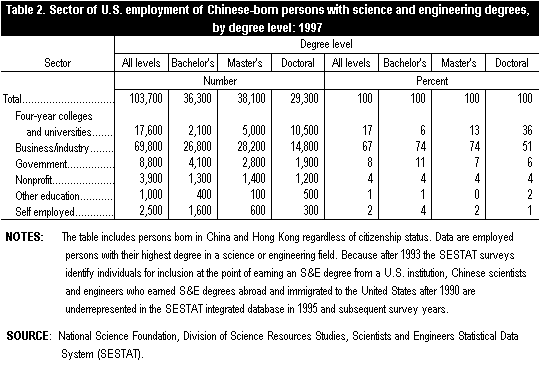
Directorate for Social, Behavioral
and Economic Sciences
NSF 01-311 January 12, 2001
Human Resource Contributions to U.S. Science and Engineering From China

More than 21,600 Chinese earned S&E doctorates at U.S. universities over the 1986-98 period.
85 percent of Chinese doctoral recipients at the time of degree conferral planned to remain in the United States for postdoctoral research or other employment.
The international flow of scientific personnel is an integral component of the modern world's creation and diffusion of knowledge in science and technology. Recent research has shown that foreign-born scientists and engineers make exceptional contributions to U.S. science in several areas, including membership in S&E academies, publication of highly cited research, and the founding of innovative companies.[1] Compared to their presence in the U.S. S&E labor force, foreign-born scientists and engineers are disproportionately represented in the National Academy of Sciences and the National Academy of Engineering. Foreign-born scientists and engineers are among the most highly cited authors in their fields and the founders/chairs of biotechnology firms.
China contributes significantly to U.S. scientific personnel with large numbers of science and engineering (S&E) graduate students and a high proportion of Chinese doctoral recipients who remain for postdoctoral research or employment in the U.S. S&E labor force. China is among the top six countries of origin of foreign-born scientists and engineers employed in the United States.
Contributions to U.S. Academic Research by Chinese Doctoral Students
U.S. academic research and development (R&D) budgets grew from $10 billion in 1980 to $25 billion in 1998, in constant dollars.[2] Along with the expanding amount of academic research, U.S. universities increased graduate student enrollment, and—particularly in the past decade—foreign graduate student enrollment.[3] Graduate students serve as research and teaching assistants for S&E subject matter.[4]
The number of Chinese graduate research assistants contributing to the conduct of U.S. academic R&D has expanded over the past decade as the number of Chinese students earning a U.S. doctorate in S&E has increased (from 200 in 1986 to almost 3,000 in the peak year of 1996[5]). Although the number of Chinese doctoral recipients declined in 1997 and rose only slightly in 1998—an occurrence possibly due to the increased capacity for graduate education in China—more than 21,600 Chinese earned S&E doctorates at U.S. universities over the 1986-98 period.
More detailed data are available for the years 1988-96 from the National Science Foundation's Statistical Profiles of Foreign Doctoral Recipients in Science and Engineering: Plans to Stay in the United States. During this period, Chinese students earned 7.5 percent of all S&E doctorates in U.S. universities—16,550 of 219,643. The highest percentage of Chinese doctorates was in the natural sciences and engineering. Chinese students earned 13 percent of the physical science and 15 percent of the mathematics doctorates awarded from 1988-96. (table 1.)
More than 80 percent of the Chinese doctoral recipients in the United States from 1988-96 reported in the Survey of Earned Doctorates that they were supported by university research assistantships,[6] and over half reported financial support from teaching assistantships.[7]
Postgraduate Contributions in Academia and the Workforce
Detailed information is also available for the period 1988-96 on foreign doctoral recipients' plans to stay in the United States following degree conferral. For this period, about 85 percent (14,000) of Chinese S&E doctoral recipients planned to remain in the United States, and 48 percent (8,000) reported accepting firm offers to do so at the time of degree conferral (figure 1). More students from China plan to remain in the United States than those from any other country.
Coincident with academic R&D increases were increases in the number of postdoctoral researchers (the majority of whom are foreign-born).[8] Over 30 percent of 1988-96 Chinese doctoral recipients had firm plans to remain in the United States to serve as postdoctorates in science or engineering. In all, more than 5,000 Chinese scientists and engineers were offered these appointments, by far the highest number from any country.[9]
About 17 percent of new Chinese S&E doctoral recipients from U.S. universities received firm offers for other types of employment in the United States. From 1988-96, firm job offers to Chinese doctoral recipients were concentrated in a few fields: engineering (1,138), physical sciences (491), and mathematics (400). Most of these job offers consisted of employment in R&D, mainly in industry.[10]
These data can be supplemented with information from the National Science Foundation's SESTAT database on scientists and engineers. In 1997, approximately 104,000 out of 10.6 million people employed in the United States whose highest degree at any level was in science or engineering reported China as their place of birth, approximately 1 percent. Of these 104,000, almost 67 percent were employed in business and industry, and 17 percent in higher education. Among Chinese S&E doctorate-holders, one-half were employed in industry and more than one-third were employed in academia (table 2).
Conclusion
China contributes significantly to the flow of scientific personnel to the United States. While graduate students, Chinese students who earned an S&E doctorate (21,600) in the United States between 1986 and 1998 conducted basic and applied research in U.S. universities and helped teach students in science, mathematics, and engineering. After earning their degrees, Chinese postdoctorates have contributed to research at U.S. universities and elsewhere. Chinese-born scientists and engineers are part of the U.S. technical labor force, particularly in business and industry.
This Issue Brief was prepared by:
Jean M. Johnson
Division of Science Resources Studies
National Science Foundation
4201 Wilson Boulevard, Suite 965
Arlington, VA 22230
703-292-7806
E-mail: jmjohnso@nsf.gov
SRS data are available through the World Wide Web (http://www.nsf.gov/sbe/srs/stats.htm). For more information about obtaining reports, contact pubs@nsf.gov. or call (301) 947-2722. For NSF's Telephonic Device for the Deaf, dial (703) 292-5090. In your request, include the NSF publication number and title, your name, and a complete mailing address.


